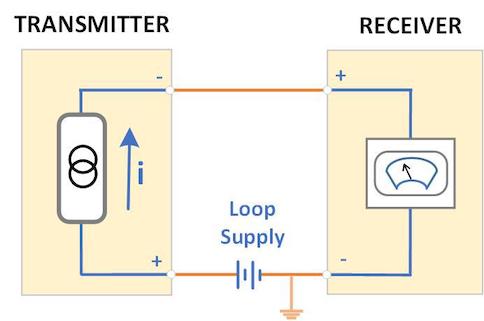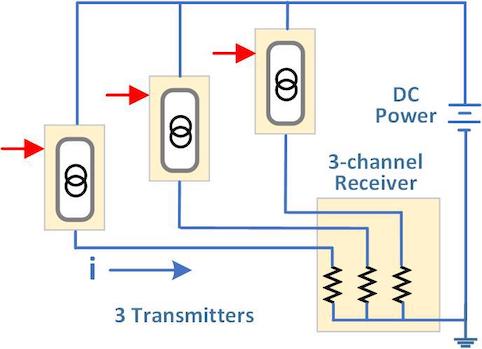Three devices are needed to make a 4-20 mA current loop – a transmitter, receiver and loop power supply.

Transmitter
The transmitter is the device that controls the current circulating in the loop. It converts a physical or electrical parameter into a 4-20 mA signal, where 4 mA represents the zero value and 20 mA is full scale. Transmitters are classified as 2-wire, 3-wire, or 4-wire. A 2-wire transmitter obtains its operating power from the current loop. This loop-powered instrument is an ideal solution when external power is not accessible. However, the amount of power available is very limited. This is helpful when operating in hazardous locations where intrinsic safety is needed. Conversely, limited power places constraints on the transmitter’s capabilities. It may lack sufficient power to drive certain types of sensors. If a loop-powered device has a display, it will typically be an LCD. At some point below 4 mA loop current, the device will stop operating.
Both 3- and 4-wire devices are powered from an external supply. This eliminates the need for a separate loop supply. The availability of extra power means these units can offer extended capabilities and additional features, such as higher sensor excitation, LED display, relay outputs and digital communications. However, these units need additional wiring compared to 2-wire devices, so the configuration is more complex and the installation cost is typically higher.
A 3-wire transmitter has one additional connection for an external dc supply. The low side of the supply is connected to the common terminal, which is also part of the current loop. In many installations, this terminal is wired to a system ground or earth. The shared connection in a 3-wire transmitter requires careful consideration of grounding issues to prevent potential ground loops. If an application using a 3-wire transmitter requires isolation in the loop, a separate dc power supply can be installed for each transmitter. Another method to provide separation is to add a loop isolator. This device accepts a 4-20 mA signal, functions as a repeater or re-transmitter, and delivers a reconstituted 4-20 mA current loop signal that is fully isolated. To avoid adding additional devices to the system, the 3-wire transmitter can be replaced with a 4-wire unit, which has isolation built-in.

A 4-wire transmitter has 2 connections to power the unit separately from the loop. In most installations, one side of the power supply is tied to ground or earth. Both loop connections float off ground, which minimizes ground loop problems in systems with multiple loops or distant receivers. Many 4-wire devices can be powered from either a dc or ac supply.
There can be only one transmitter in a current loop. Devices with a 4-20 mA transmitter output are found under various categories on the Weschler website, including Current Transducers, Flow Sensors, Pressure Sensors, Temperature Transmitters, and Signal Isolators.
Receiver
The receiver is a device, such as a meter, recorder, actuator, control or SCADA module, that reads the loop current. Devices with a mA input include Analog Panel Meters, Digital Panel Meters, Bargraph Meters, Process Meters, Meter Relays, Controllers, Process Recorders and Loop-Powered Indicators. Rather than measure milliamps directly, many applications insert a resistor in the loop to convert the current into a voltage. A voltmeter is then used to measure the drop across this resistor. Common values are 250W for a 1-5V signal and 500W for a 2-10V signal.
Loop-powered receivers obtain their operating power from the 4-20 mA loop and have no additional system connections. Some receivers have the input low connection internally tied to system ground. This is often encountered in instruments with multiple inputs, such as recorders or PLCs. The most flexible receivers have floating inputs that are isolated from their power connections, similar to 4-wire transmitters. The receiver input configuration is another factor to consider when analyzing system grounds, commons and signal returns. More than one receiver can be wired in series in a loop, provided the loop supply voltage is adequate and the input of the additional receiver(s) can be floated off ground. Externally powered receivers may offer relay or control outputs, digital communications and other extended features. Some meters and controllers also provide a 4-20 mA output to retransmit the measured signal.
Power Supply
The power supply provides the loop current and may also power transmitters and receivers. 24V is a typical value, although 10, 15, 28 and 36 volts are also used in some installations. For loops with 2-wire devices, the power supply only provides the loop current. Multiple loops can be operated from one power supply if it is rated to drive the maximum current in all loops and the receivers share a low connection.

Some receivers include an excitation source, typically 24V dc, to provide loop or transmitter power. This internal supply may be fully isolated or have one side tied to the receiver input low. For loops with 3-wire and 4-wire devices, the supply must be rated to power the transmitter and/or receiver as well as provide the loop current. In large installations with multiple loops, one supply is often used to power a number of transmitters (and provide the loop currents), while a different supply powers a cluster of distant receivers. The use of 4-wire devices reduces issues with noise and ground differentials often encountered in large installations.
Current loops continue to see wide use in industrial control systems. The 4-20 mA standard is broadly supported with thousands of available devices. Simple operation, high noise rejection, easy fault detection and immunity to cyber-attack make them attractive as both a primary and backup monitor/control method.
